
NORTH PEMBROKESHIRE & FISHGUARD RAILWAY - BRIEF HISTORY[Source: Nick Catford] The South Wales Railway was incorporated on 4 August 1845. It was always, in effect, a subsidiary of the Great Western Railway, and a perpetual lease by the GWR of the SWR in December 1846 was agreed to start from the completion to Fishguard. There were difficulties about the route at the Gloucester end of the South Wales Railway, and Brunel began to have misgivings about the suitability of Fishguard, which at the time had no sheltered harbour facilities. In 1845 there was widespread loss of the potato crop on which the majority of Irish people depended for a living, resulting in mass starvation and commercial depression, which deepened the following year. The catastrophe is known as the Great Famine, and also as the Irish Potato Famine. With unfortunate timing, the Waterford, Wexford, Wicklow & Dublin Railway secured its authorising Act of Parliament on 16 July 1846 with capital of £2 million. Observing the deepening crisis in Ireland, the WWW&DR Company cut back its plans and declared that it could not build to Wexford. For the time being a rail and ferry route to Dublin via Fishguard was impossible. Brunel had all along entertained thoughts of developing the transatlantic shipping trade from south-west Wales, and he declared this in 1844. Whereas the Irish ferry service was reliant on the shortest possible sea crossing, transatlantic shipping had different priorities. Linking with his doubts about the general suitability of Fishguard, he agreed with the Board of the South Wales Railway that it would not now build to Fishguard. A branch of the planned Fishguard line was to run to Haverfordwest and the decision was taken to extend that line to a harbour on Milford Haven, where there was a deep anchorage. The railway's terminus was given that name, but later it was changed to Neyland, and another harbour and station nearby was named Milford Haven. The lease of the SWR by the GWR had been interrupted by the decision not to build to Fishguard, but in March 1852 a new lease was agreed, and abandonment of the Clarbeston Road to Fishguard section was sanctioned by Parliament in that year. The South Wales Railway was publicly opened as far as Haverfordwest on 2 January 1854, and from there to Neyland on 15 April 1856. A twice weekly steamer service to Waterford, and other services were started gradually. The terminus, 'Milford Haven', was renamed Neyland in 1859 and then changed again to New Milford by December 1859.
Narberth Road and Maenclochog Railway In July 1871 Cropper and his stepson, Joseph Babington Macaulay who operated the Rosebush quarry, applied for a Board of Trade certificate under the Railways Construction Facilities Act, 1864. This was a low-cost means of getting a line authorised without an Act of Parliament where landowners were agreeable to the construction and there was no other infringement of the public interest. Captain Tyler of the Board of Trade visited the site in October 1871; the line was now to be standard gauge as by then it was known that the GWR would shortly be converting the gauge of the South Wales Railway from broad to standard. The certificate was issued on 24 June 1872. The cost of construction was stated to be £42,267, a considerable sum then. Although the line would terminate at the village of Rosebush it was named the Narberth Road & Maenclochog Railway, Maenclochog being a larger village south of Rosebush.
The Board of Trade certificate authorised a single-track line 8 miles 29 chains in length running in the valley of the Eastern Cleddau river to the South Wales Railway a mile west of Narberth Road. Here it would turn east running parallel with the GWR to a junction at Narberth Road station. There was an agreement with the Great Western Railway that that company would lay a third track alongside its main line to allow Cropper's trains to reach Narberth Road. There was sufficient room in the existing GWR cutting following the regauging and it seems likely that construction of the new line was delayed until after the gauge conversion.
Although slate traffic was the reason for building the line, passenger operation was contemplated at the planning stage: a clause in the authorisation required Cropper to arrange for one train daily to call at a station whose location was to be agreed with the Traffic Commissioners. When completed, the line had the steepest gradient on a standard gauge line in Britain, with gradient of 1 in 27 for about 1 mile 69 chains which took the line through the 100yd unlined Castle (Maenclochog) Tunnel. The large number of cuttings and embankments required and stretches of waterlogged ground and a certain amount of friction between the English, Welsh and Irish navvies all contributed to the slow construction of the line. One incident of note was the ‘Maenclochog murder’ of 13 October 1874, when one navvy was killed after a period of heavy drinking. Despite strong evidence against them, the three defendants were acquitted by the court.
Slate traffic appears to have been carried on the line from January 1876; some unofficial passenger journeys may have been made before that date by the courtesy of the contractor. Colonel C S Hutchinson RE inspected the line on 3 May 1876 on behalf of the Board of Trade for planned public opening, but he was dissatisfied with the planned arrangement at Narberth Road for branch trains and he declined to give approval. Different arrangements were put in hand and when he re-inspected in September, Hutchinson approved the opening. The line opened for passenger traffic on 19 September 1876 with the usual celebrations to mark the opening of a new line including a free train service on the opening day. The initial timetable had four passenger trains each way daily; up trains were allowed 35 minutes to complete the journey while down trains were allowed an additional five minutes because of the steep gradients.
There were stations at Llanycefn, Maenclochog and Rosebush, each having goods facilities. There was also a 'fare stage' at Beag where there was also a public goods siding. At Clynderwen a short bay was added at the back of the up platform. Signalling was provided by Messrs McKenzie & Holland of Worcester, with signal boxes being built at Llanycefn, Maenclochog and Rosebush. The line was worked by ‘one engine in steam’, although there was a crossing loop at Maenclochog which might have been modified to allow two trains to operate on the line at the same time.
Passenger traffic was buoyant despite the sparsely populated area though which the line passed with 6,675 passengers being carried and 6,690 tons of freight being handled in its first seven months. The two quarries were profitable and, apart from slate, other freight traffic included household coal, cattle and lime which were used to improve the poor soil of the area. Despite a healthy combined revenue of £654.8.1d, the line was not profitable because of the high rental charges imposed by the GWR at Clynderwen station; this consumed most of the profit. Edward Cropper died in 1877 and his eldest son Edward Denman Cropper took over the railway. Joseph Macauley was General Manager of the railway as well as running Rosebush Quarry.
Reaching Fishguard had long been an aspiration of both Edward Cropper and others, and an independent company, the Rosebush & Fishguard Railway, was promoted by a consortium headed by Sir Hugh Owen. An Act of Parliament on 8 August 1878 authorised the company to build a line of 13 miles 73 chains, running from a junction with the Maenclochog Railway at Rosebush through Puncheston and Letterston to Goodwick, on Fishguard Bay. There were running powers over the Maenclochog Railway; authorised capital was £90,000 and five years were allowed to complete the line.
Initially relations with the Maenclochog Railway were good with Joseph Macaulay, the manager of the Maenclochog Railway, being appointed as Owen’s deputy. Applyby & Lawton were appointed as the contractor but from the beginning the new company struggled to raise capital. Despite this, construction began shortly after the first sod was cut on 28 August 1879. Progress was very slow and after a year the line had only reached New Inn, less than a mile from Rosebush owing to difficulties in purchasing land.
Relations with the Maenclochog Railway went rapidly downhill when Edward Cropper Jnr left the company to fight in the Zulu wars in 1879. Control of the company passed to his younger brother James..
In 1881 a three-year extension was authorised by Parliament and at the same time agreement was reached with the Maenclochog Railway to operate the two lines (when complete) as a single entity. Even this new time extension proved not to be fruitful and the work was stopped by August that year because the contractor, Appleby & Lawton had not been paid for a mile of formation already completed.
In an effort to boost passenger revenue, the Maenclochog Railway started promoting the line as a tourist attraction. The Prescelly Hotel was built at Rosebush with the intention of it becoming a health resort and spa. This never came to fruition when analysis of the water in the ‘lakes’ at Rosebush proved them to be peaty with no medical properties. A further unusual attempt to boost revenue came in 1882 when Colonel John Owen, owner of the Bellstone Quarry arranged for his unit, the Royal Pembrokeshire Artillery, to be taken on a military ‘troop train’ from Haverfordwest to Clynderwen, then over the Maenclochog Railway to Rosebush from where they route marched to Clarbeston Road on the South Wales line.
Despite all attempts to increase revenue the high rental charged that were still being imposed by the GWR continued to prove crippling and, after a further period of decline, the line was closed from 1 January 1883. In 1883 the abandonment of the Rosebush and Fishguard Railway was considered, but in the following year a new Act was obtained (on 7 August 1884), allowing a further extension of time, and changing the name of the project to the North Pembrokeshire & Fishguard Railway. Relations with Maenclochog Railway remained poor and although the line had now closed James Cropper refused permission for plant and wagons to approach the Rosebush works over his railway; the NP&FR had to insist on exercising their running powers, previously laid down by Parliament.
The Maenclochog Railway reopened on 5 December 1884, and there were then two passenger trains daily, and some carryings of slate, but the reopened company was no more successful than previously, and it closed the line again from 25 May 1887. An attempt was made to sell the line to the NP&FR for £20,000 but they had insufficient capital to buy it. In 1886 a further Act was granted allowing the NP&FR a further extension of time; although the contractor agreed to restart work in order to, in the long run, recover the money owing to them the work did not commence. The Maenclochog Railway was offered for sale by auction on 20 February 1889, but no sale took place and the line went into dormancy with occasional trains being run to comply with legal requirements. To oversee this, the traffic manager was retained at his office at Clynderwen for some time.
Towards the end of 1891 Colonel Joseph Okell from Liverpool arrived on the scene. He undertook to complete the NP&FR and provide the necessary finance. A new contractor, Henry Jackson, was appointed and by March 1893 the works had reached Puncheston where construction was slowed by heavy rain and boggy ground. In January 1894 Okell was declared bankrupt, and that was the end of any financial assistance from him. Now two more men of means came on the scene: Joseph Rowlands, a solicitor from Birmingham, and James Cartland, a brass-founder, also from Birmingham. They acquired a majority shareholding in the NP&FR, and their objective became clear when they floated a new company, the Fishguard Bay Railway & Pier Company. This was incorporated by Act of 29 June 1893, to construct a 74-chain line from Goodwick, where the North Pembrokeshire was to terminate, and to run to the west side of Fishguard Bay. A 350yd pier was to be constructed as well as a hotel, and running powers over the North Pembrokeshire line were granted. The company's capital was to be £120,000. The partners also undertook to improve the harbour at Rosslare. The following year this new venture became the Fishguard and Rosslare Railways & Harbour Company. The Waterford & Wexford Railway was engaged in improving the harbour facilities at Rosslare, and negotiations took place to combine the activities on both sides of the ferry crossing. This culminated in the incorporation of the Fishguard and Rosslare Railways & Harbours Company by Act of 31 July 1894. Shortly before this took place, Rowlands and Cartland negotiated to purchase the derelict Maenclochog Railway in 1894 for £50,000. By the end of 1894 NP&FR had reached Letterston. The Maenclochog line was by now in a very poor state of repair, and much remedial work had to be undertaken to satisfy the Board of Trade inspector who was booked to visit the line on 31 January 1895, but this inspection was delayed until 12 March because of heavy snow. The refurbished Maenclochog line was inspected on 18 March. Having completed his inspection Col Yorke RE required only minor defects to be corrected, including signalling and other issues at Clynderwen, which were the responsibility of the GWR. These were corrected immediately. Goods traffic (not requiring Board of Trade approval) started on 13 March 1895 and passenger trains on 11 April 1895; Yorke made a confirmatory visit in July. There were three up and four down passenger trains daily to and from Letterston, with a coach connection from Fishguard. Freight traffic included coal, lime, feedstuffs and cattle, but there is no record of slate being carried so it is likely the quarries at Rosebush had ceased production by this time. Signalling was provided by McKenzie & Holland. Alan Nichols was appointed General Manager of the line. The NP&FR submitted a bold proposal to Parliament in 1895 for an extension of their line to Carmarthen, and overtures were made to the London and North Western Railway as to their possible acquisition of the whole line, but the LNWR was lukewarm on the matter. Nonetheless the powers for the extension, and also a deviation to avoid the worst of the gradient on the Maenclochog line, were obtained. In 1896 the NP&FR carried 26,824 passengers and 15,000 tons of goods, bringing in combined revenue of £3,360 which meant that the line was running at a loss having outgoings of £5, 136. Despite this loss, plans went ahead for further expansion. A contract for the authorised extension line from Letterston to Fishguard was also awarded at this time. The contractor was Holme & King of Liverpool who agreed to complete it by 29 September 1897.
In 1896 the FBR&P submitted even more ambitious schemes to Parliament, to reach Aberdare and make junctions with the LNWR, the Midland Railway and the GWR en route. In 1897 the Fishguard and Rosslare Railways & Harbours Company was in Parliament consolidating its planned operation of ferries, harbours on both sides of the crossing, hotels and ancillary works. However, dramatic events unfolded as the F&RR&H Company suddenly indicated an unwillingness to proceed, and part of the fallout was that the FBR&P Company withdrew the Aberdare extension scheme. The F&RR&H Company became a joint enterprise of the Great Western Railway and the Great Southern & Western Railway. In February 1898 the situation regarding the F&RR&H clarified, when Alexander Henderson of the City of London purchased the entire F&RR&H undertaking, including the railway at Fishguard. He also purchased the NP&FR for £157,500. By 12 August 1898 an Act for the F&RR&H was passed, requiring the GWR to operate an efficient steamer service between Fishguard and Rosslare, and to provide a service of passenger and goods trains to Fishguard. The GWR took over the NP&FR (by agreement of 12 February 1898), but it was recognised that the line with its sharp curves and very steep gradients was unsuitable as a through line. The GWR acknowledged the necessity of building a new direct line between Clarbeston Road and Letterston, also authorised by Parliament in 1898. Revival of the idea of generating transatlantic traffic from Fishguard was confirmed at the same time.
Construction of the 6 miles 14 chains single-track extension of the line from Letterston to Goodwick was delayed but was eventually completed by the Great Western ready for inspection by Lt Col Yorke RE for the Board of Trade on 15 June 1899. Only minor alterations were required and Col Yorke authorised the opening of the line to all traffic. This happened on 1 July 1899 when the first train to travel over the full length of the North Pembrokeshire line left Goodwick at 7.25 am with 163 passengers being carried on the first day.
The 1899 Great Western Railway Act ratified the absorption of the NP&FR by the Great Western; the former North Pembrokeshire & Fishguard Railway was now known as the North Pembrokeshire branch of the GWR. From the outset there were three passenger trains a day in each direction with one each way being mixed. With crossing loops only at Maenclochog and Letterston there was little chance of improving the service. The civil engineering work at Fishguard and at Goodwick was on a considerable scale, much blasting and rock excavation being needed for the harbour and by the GWR on shore to create space for railway facilities. Much of the alignment of the new direct line was to follow Brunel's original 1840s Fishguard route, but a start was delayed and certain deviations were authorised by the GWR (New Works) Act of 1903. The new line merged into the NP&FR line at Letterston Junction.
There were still three trains a day on the North Pembrokeshire branch in 1910. The North Pembrokeshire branch was to play its part in the war effort during WW1. In 1916 the Ministry of Munitions asked the GWR to provide 40 miles of track for use in France. A number of branches were selected for closure to provide this track and one of these was the North Pembrokeshire. The service between Clynderwen and Letterston was withdrawn from 8 January 1917. After closure, the passenger service to Letterston was maintained by rail-motors on the Fishguard - Neyland service being diverted along the branch requiring a reversal to Letterston Junction. This arrangement was, however, short-lived and for the remaining duration of the war there was one ordinary train, one goods train and one rail-motor in each direction.
The closure was not popular with local businesses that relied on the line for the delivery of goods. As a result of this protest, the goods service from Clynderwen to Maenclochog was reinstated on 22 January 1917. The remaining track between Maenclochog and Letterston was lifted with 11 miles of rails being transported to France. After the war the North Pembrokeshire branch reopened in stages. The line reopened form Maenclochog to Rosebush on 12 July 1920 and from Rosebush to Puncheston on 14 November 1921. The pre-war service of three passenger trains in each direction was reintroduced. It was not until 9 July 1923 that the final 4¼ miles to Letterston was re-laid with a through passenger service using rail-motors being introduced. By 1924 the service reverted to mixed trains with three down and two up and a daily goods from Fishguard. As road transport became more popular throughout west Wales a number of halts were opened in an effort to boost passenger traffic. The first of these at Jordanston between Fishguard & Goodwick and Letterston Junction; this opened on 1 October 1923. From 15 September 1926 the mixed trains were withdrawn and replaced by auto trains with a single goods service running from Fishguard. Four additional halts were opened on the North Pembrokeshire line in an attempt to further boost passenger traffic. Beulah Halt and Castlebythe Halt opened on 24 September 1928. New Inn Bridge Halt opened 14 October 1929 and Martel Bridge Halt on 1 January 1930. Despite the opening of the new halts with some increase in passenger revenue the North Pembrokeshire line was still running at a loss and closure was announced. It was initially intended to close the line from September 1937, but the closure was deferred until 25 October 1937. This left one daily freight train which left Fishguard at 10.55am, arriving at Clynderwen at 2.50pm. If required an engine and van from this train would be despatched to Maenclochog to operate the 5.15 pm parcels (parcels means rabbits) service to Clynderwen.
In 1938 Royal Navy Armaments Depot, Trecwn was established. It was located a few miles north of Letterston, and it was served by a new 2½-mile line off the North Pembrokeshire branch, between Letterston and Letterston Junction. In addition, there was an extensive narrow gauge railway system in the depot.
In 1941 the RAF and USAF wanted to practice air attacks on trains. To accommodate this the North Pembrokeshire line was closed between Puncheston and Letterston on 3 November 1942. It is not known if there were any air attacks on the line, but when it was inspected on 14 March 1943 no damage was found and the line reopened in April. This was to be short- lived as it closed again on 21 July to allow a planned air attack on a locomotive near Puncheston. A modified version of the so-called bouncing bomb was developed after the famous Dam Busters raid (Operation Chastise) for land use. The bomb was intended to be projected into a railway tunnel and explode there blocking the tunnel. Tests were carried out at the Maenclochog Tunnel on 7 October 1943, with the inventor Barnes Wallis in attendance. Evidently the bombing was not decisive, for the line was reopened after repairs later in the war between Puncheston and Clynderwen.
With only one train a day that could accommodate only a maximum of 12 wagons there was clearly no future for freight traffic on the North Pembrokeshire branch and the service was withdrawn between Letterston and Clynderwen on 16 May 1949. The track was lifted in 1952 leaving just the stub to Letterston from Letterston Junction. This survived until 1 March 1965 when Letterston closed to goods traffic. The track to the junction with the Trecwn branch was lifted in the summer of 1965. The Trecwn branch was then reclassified as a siding. After World War II the depot at Trecwn continued to have strategic importance during the Cold War but it was decommissioned in 2002 and the last remnant of the North Pembrokeshire branch closed.
Route map drawn by Alan Young. Airey's map from Alan Young Sources:
|
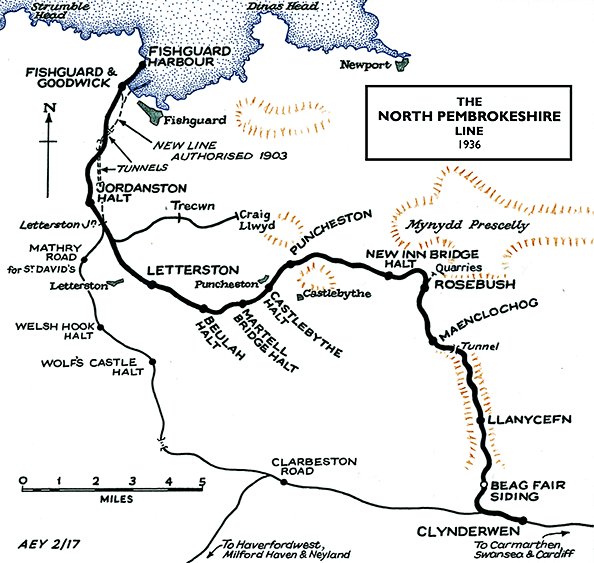
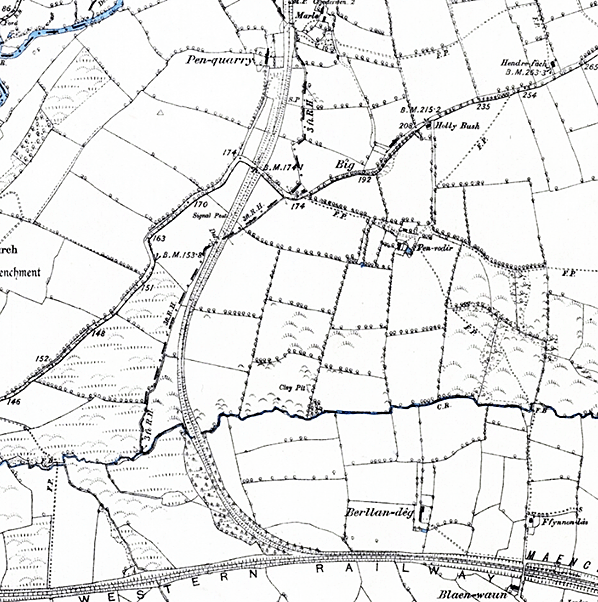 1888 1:10560 OS map showing the junction with the GWR west of Clynderwen. Baeg Siding is seen at the top of the map just south of Pen Quarry.
1888 1:10560 OS map showing the junction with the GWR west of Clynderwen. Baeg Siding is seen at the top of the map just south of Pen Quarry.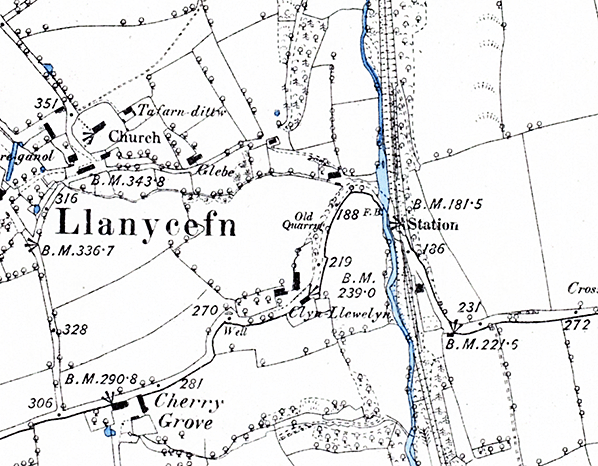 1888 1:10560 OS map - Llanycefn station
1888 1:10560 OS map - Llanycefn station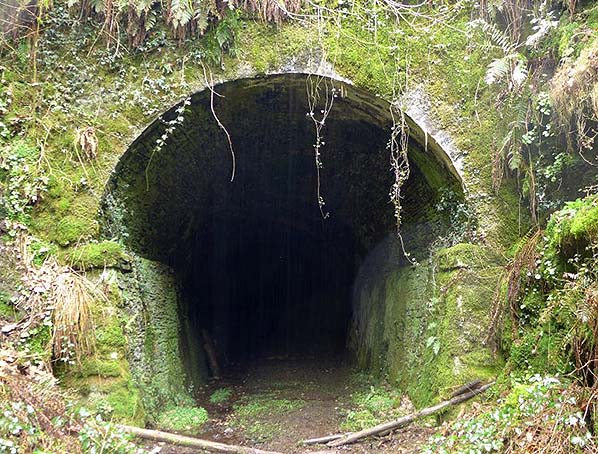 The south portal of Maenclochog Tunnel in March 2017. On 6 October 1943, the tunnel played a small but notable part in the war effort, acting as the target for a prototype Highball bouncing bomb which was dropped from a Mosquito flying out of RAF Angle It was flown by Sqn Ldr Longbottom and he managed to get 4 out of 12 Highballs to go through the tunnel whilst two hit the portal. The tunnel was closed for a day for the test, and was quickly repaired. Click
The south portal of Maenclochog Tunnel in March 2017. On 6 October 1943, the tunnel played a small but notable part in the war effort, acting as the target for a prototype Highball bouncing bomb which was dropped from a Mosquito flying out of RAF Angle It was flown by Sqn Ldr Longbottom and he managed to get 4 out of 12 Highballs to go through the tunnel whilst two hit the portal. The tunnel was closed for a day for the test, and was quickly repaired. Click 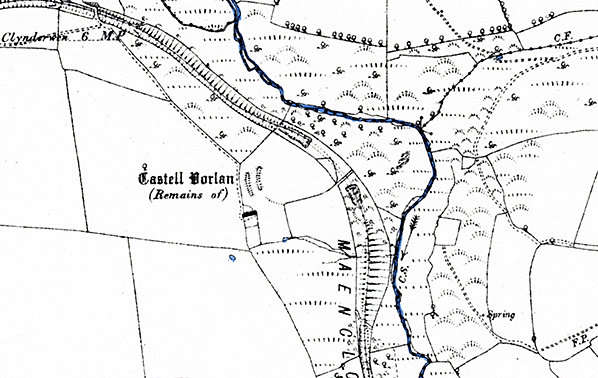 1888 1:10560 OS map - Castle or Maenclochog Tunnel.
1888 1:10560 OS map - Castle or Maenclochog Tunnel.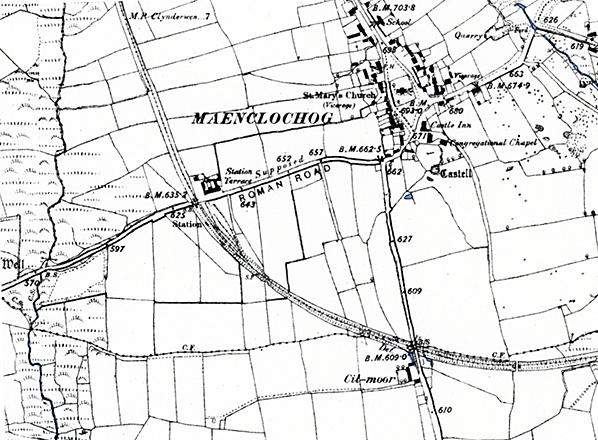 1888 1:10560 OS map - Maenclochog Station.
1888 1:10560 OS map - Maenclochog Station.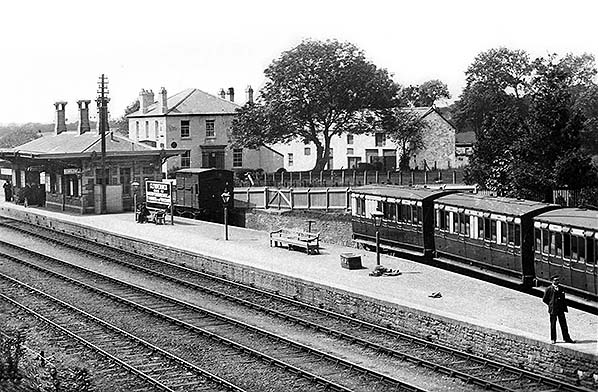 Clynderwen station before November 1905. The station was renamed Clynderwen on 1 December 1875, being named after the Clynderwen Estate, which included property in the area around the station. The junction with the Maenclochog Railway was to the west of the station and the NR&MR trains to Rosebush used a bay at the eastern end of the up side of the station. Initially trains had to reverse in and out of the platform, but with the extension of the Rosebush line to Letterston by the North Pembrokeshire and Fishguard Railway (NP&FR) in 1895 the layout at Clynderwen was improved.
Clynderwen station before November 1905. The station was renamed Clynderwen on 1 December 1875, being named after the Clynderwen Estate, which included property in the area around the station. The junction with the Maenclochog Railway was to the west of the station and the NR&MR trains to Rosebush used a bay at the eastern end of the up side of the station. Initially trains had to reverse in and out of the platform, but with the extension of the Rosebush line to Letterston by the North Pembrokeshire and Fishguard Railway (NP&FR) in 1895 the layout at Clynderwen was improved.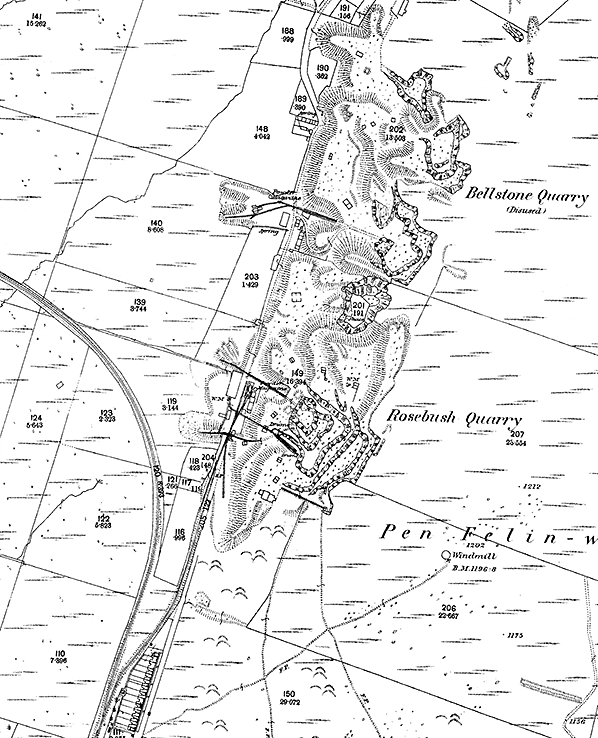 1889 1:2,500 OS map showing Rosebush and Bellstone Quarry and the connection to the Maenclochog Railway. This was a slate quarry and had provided slate for the roof of the Palace of Westminster, presumably during the post-fire rebuild which commenced in 1840 and took thirty years to complete. It is said slate from Rosebush and Bellstone was not of especially good quality for roofing but was excellent for building blocks. Today the old quarry is accessible by the public and its lakes popular for swimming. Click
1889 1:2,500 OS map showing Rosebush and Bellstone Quarry and the connection to the Maenclochog Railway. This was a slate quarry and had provided slate for the roof of the Palace of Westminster, presumably during the post-fire rebuild which commenced in 1840 and took thirty years to complete. It is said slate from Rosebush and Bellstone was not of especially good quality for roofing but was excellent for building blocks. Today the old quarry is accessible by the public and its lakes popular for swimming. Click 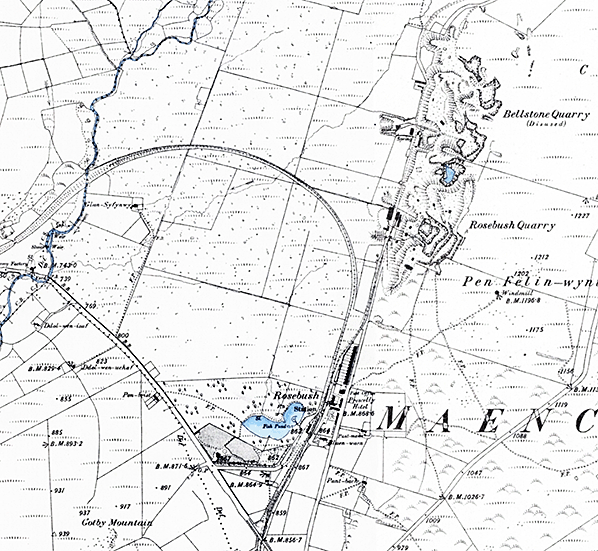 1888 1:10560 OS map - Rosebush station and quarries. Construction of the North Pembrokeshire & Fishguard Railway has started by the track doesn't go far beyond Rosebush.
1888 1:10560 OS map - Rosebush station and quarries. Construction of the North Pembrokeshire & Fishguard Railway has started by the track doesn't go far beyond Rosebush.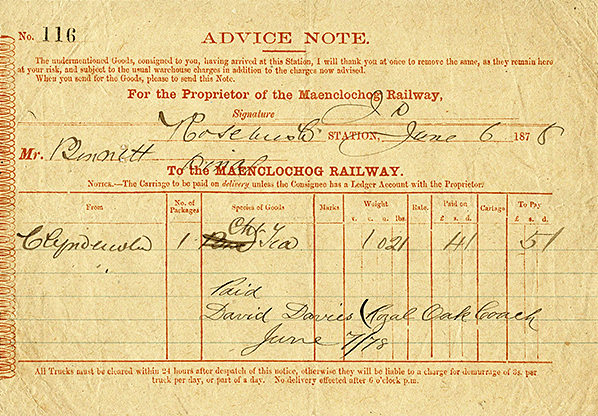 From Ian Dinmore/
From Ian Dinmore/ 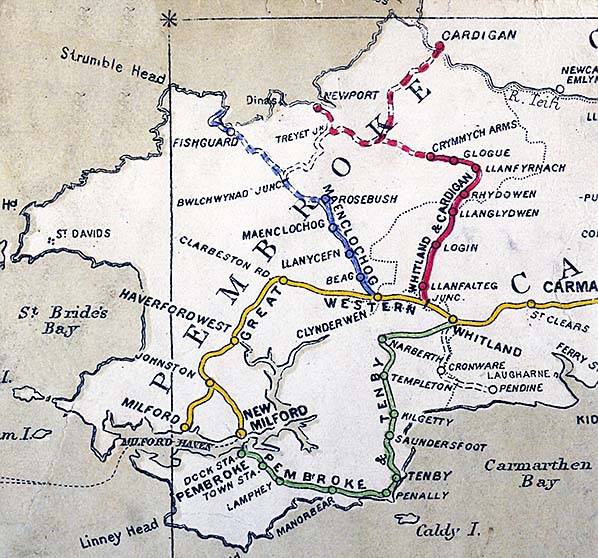 Airey's map of 1881 shows a number of proposed line that were never built including a different route to Fishguard than the line that was eventually built. This included a junction at Bwlchwynad from where a line ran to Newport which would also be reached from the Cardigan branch. Newport didn't get either line and was never on the railway map.
Airey's map of 1881 shows a number of proposed line that were never built including a different route to Fishguard than the line that was eventually built. This included a junction at Bwlchwynad from where a line ran to Newport which would also be reached from the Cardigan branch. Newport didn't get either line and was never on the railway map.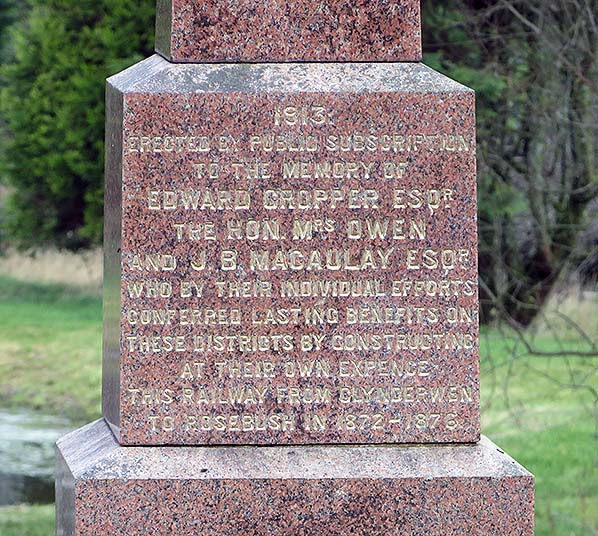 It was Edward Cropper who, having purchased the Rosebush slate quarry in 1869, was subsequently responsible for the construction of the railway from Clynderwen to Maenclochog and Rosebush for the purpose of transporting slates from the quarry. A memorial to his enterprise stands close to the site of Rosebush station and the Prescelly Hotel.
It was Edward Cropper who, having purchased the Rosebush slate quarry in 1869, was subsequently responsible for the construction of the railway from Clynderwen to Maenclochog and Rosebush for the purpose of transporting slates from the quarry. A memorial to his enterprise stands close to the site of Rosebush station and the Prescelly Hotel.
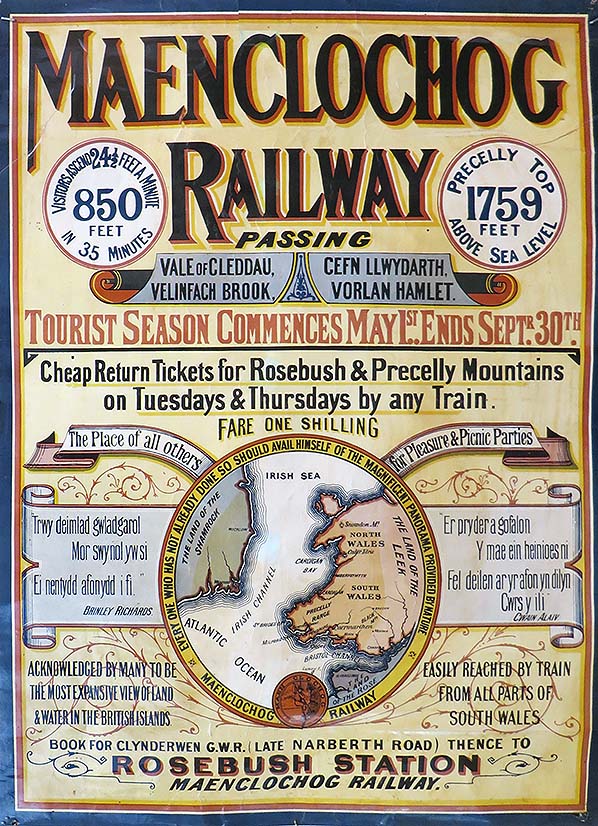
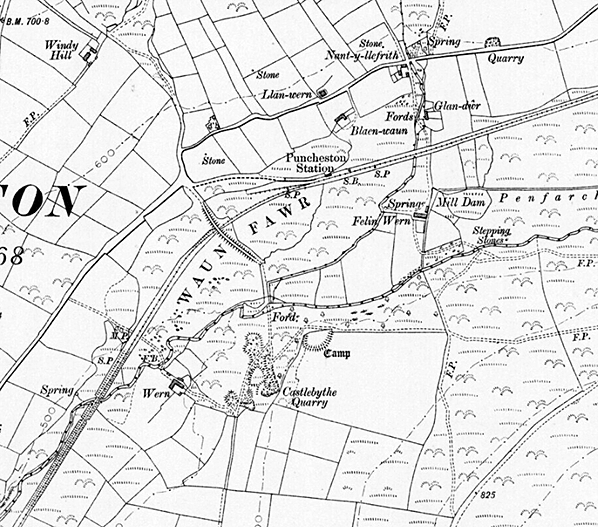 1908 1:10560 OS map - Puncheston station.
1908 1:10560 OS map - Puncheston station.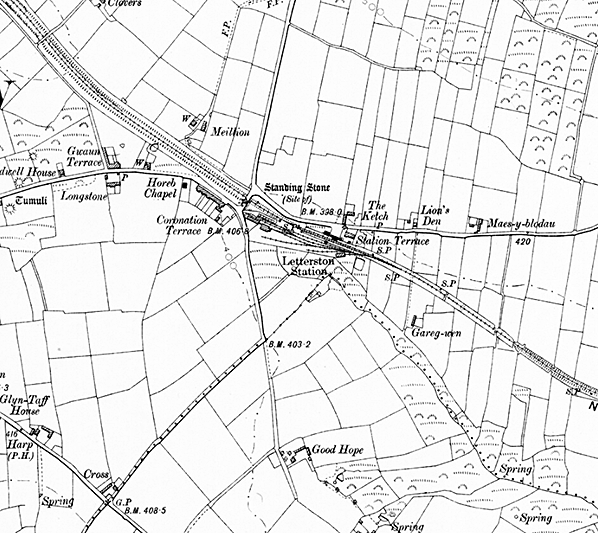 1888 1:10560 OS map - Letterston station.
1888 1:10560 OS map - Letterston station.junction1.jpg) Letterston Junction looking south c1908. The North Pembrokeshire branch is to the left with the new direct line between Clarbeston Road and Letterston on the right.
Letterston Junction looking south c1908. The North Pembrokeshire branch is to the left with the new direct line between Clarbeston Road and Letterston on the right.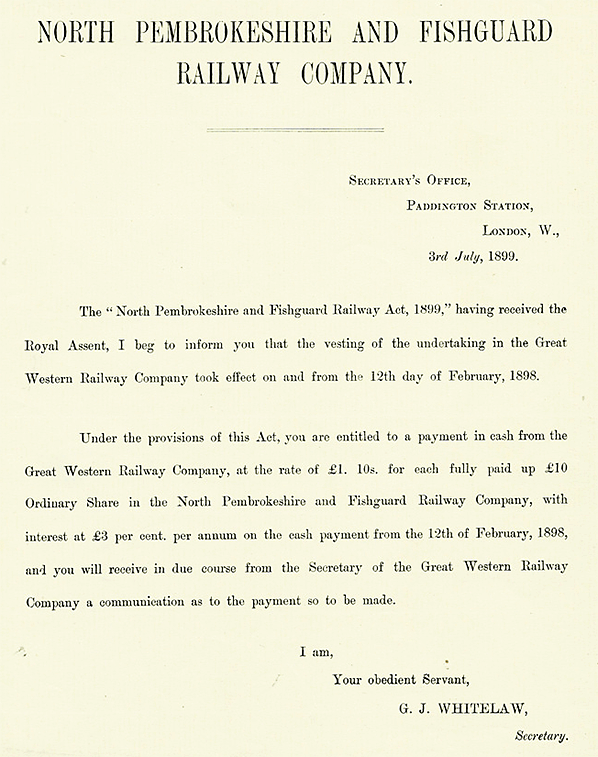 From Ian Dinmore/
From Ian Dinmore/ 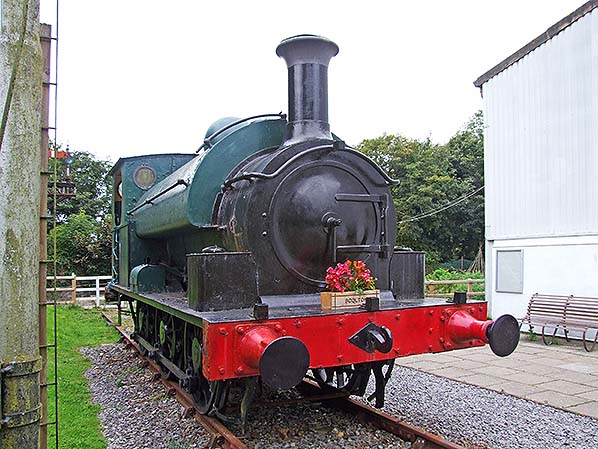 Margaret, an 0-6-0 saddle tank was built by Fox, Walker and Co. in November 1878 for the Narberth Road and Maenclochog Railway. Margaret is the third locomotive purchased by the company in 1878 and was presumably named after Edward Cropper's wife. The locomotive was given GWR number 1378. She was sold onto the Gwendraeth Valley line in 1910 becoming a GWR loco again in 1923 and then sold again to the Kidwelly Tinplate Co. Ltd. in March 1923. She was withdrawn in 1941 and rescued and restored 40 years later. Margaret is currently on display at Scolton Manor Museum near Haverfordwest but is currently in poor condition. Pembrokeshire County Council say the locomotive is included in their long term plans for the development of the site. Click
Margaret, an 0-6-0 saddle tank was built by Fox, Walker and Co. in November 1878 for the Narberth Road and Maenclochog Railway. Margaret is the third locomotive purchased by the company in 1878 and was presumably named after Edward Cropper's wife. The locomotive was given GWR number 1378. She was sold onto the Gwendraeth Valley line in 1910 becoming a GWR loco again in 1923 and then sold again to the Kidwelly Tinplate Co. Ltd. in March 1923. She was withdrawn in 1941 and rescued and restored 40 years later. Margaret is currently on display at Scolton Manor Museum near Haverfordwest but is currently in poor condition. Pembrokeshire County Council say the locomotive is included in their long term plans for the development of the site. Click 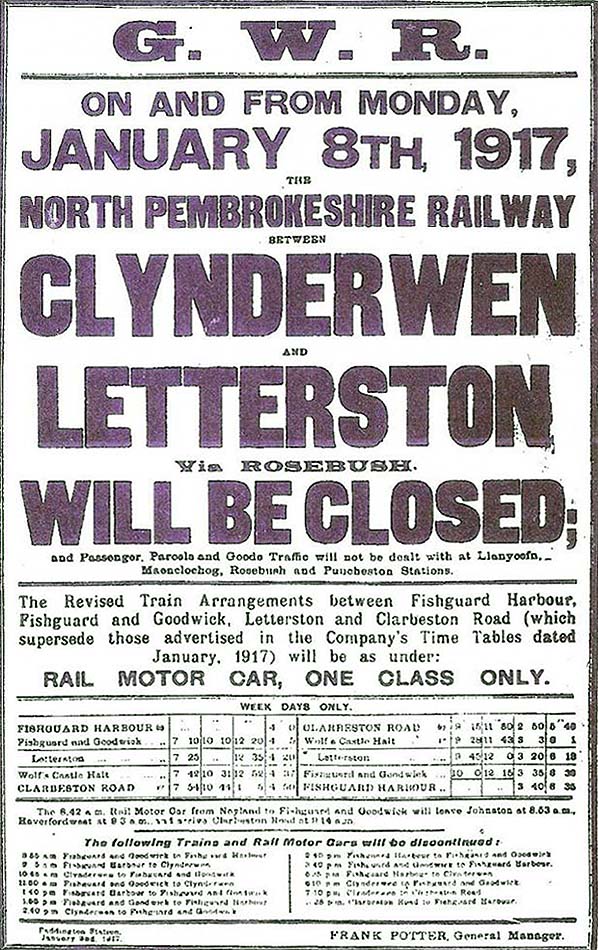
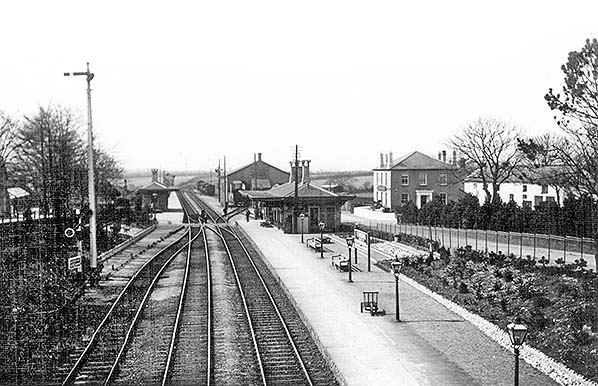 After closure of the North Pembrokeshire line to passengers in 1937 the bay platform at Clynderwen was filled in with a station garden being planted on the infilled track bed.
After closure of the North Pembrokeshire line to passengers in 1937 the bay platform at Clynderwen was filled in with a station garden being planted on the infilled track bed.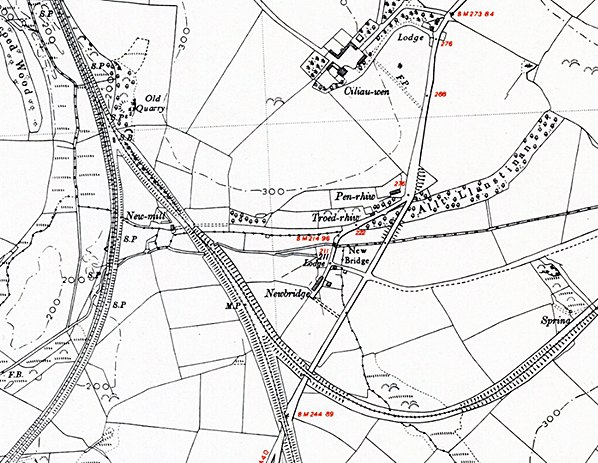 1953 1:10560 OS map - Letterston Junction is seen at the top, the signal box (SB) is marked. Heading south-east the North Pembrokeshire line soon reaches Trecwn Junction. Trecwn is to the left and Letterston to the right.
1953 1:10560 OS map - Letterston Junction is seen at the top, the signal box (SB) is marked. Heading south-east the North Pembrokeshire line soon reaches Trecwn Junction. Trecwn is to the left and Letterston to the right.junction2.jpg) Letterston Junction signal box circa late 1960s. The only part of the North Pembrokeshire branch that was still open at this time was the Trecwn Royal Navy Armaments Depot.
Letterston Junction signal box circa late 1960s. The only part of the North Pembrokeshire branch that was still open at this time was the Trecwn Royal Navy Armaments Depot.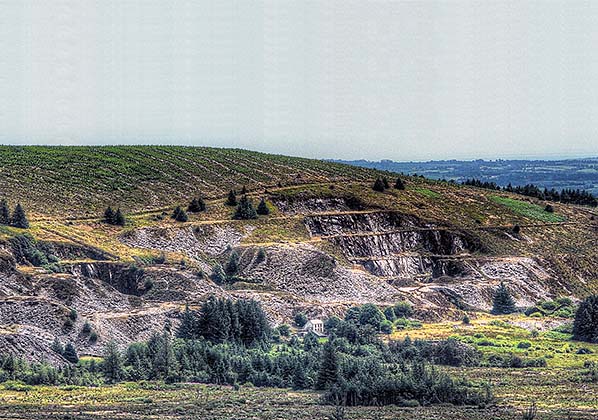 Rosebush Quarries in 2016.
Rosebush Quarries in 2016.
 Home Page
Home Page